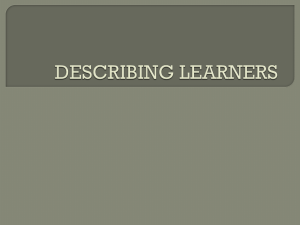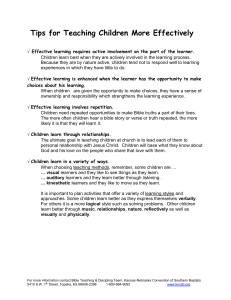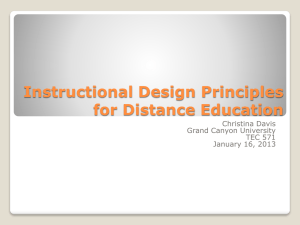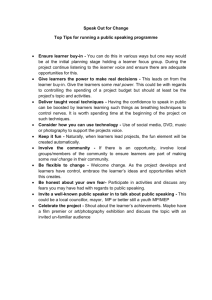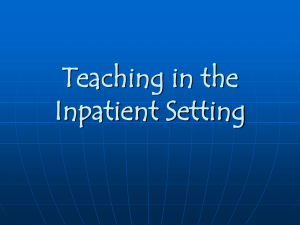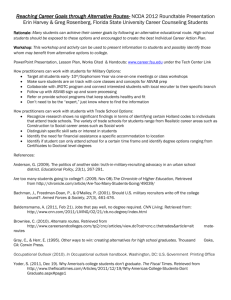Vocab document - MedBiquitous Wiki
advertisement
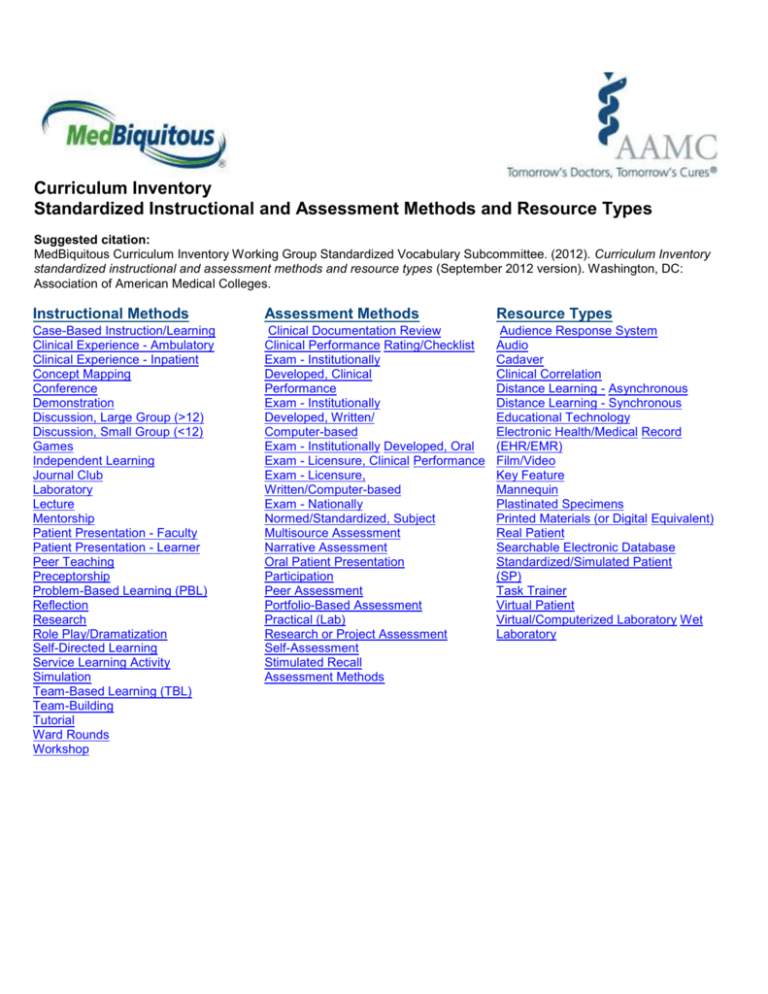
Curriculum Inventory Standardized Instructional and Assessment Methods and Resource Types Suggested citation: MedBiquitous Curriculum Inventory Working Group Standardized Vocabulary Subcommittee. (2012). Curriculum Inventory standardized instructional and assessment methods and resource types (September 2012 version). Washington, DC: Association of American Medical Colleges. Instructional Methods Assessment Methods Resource Types Case-Based Instruction/Learning Clinical Experience - Ambulatory Clinical Experience - Inpatient Concept Mapping Conference Demonstration Discussion, Large Group (>12) Discussion, Small Group (<12) Games Independent Learning Journal Club Laboratory Lecture Mentorship Patient Presentation - Faculty Patient Presentation - Learner Peer Teaching Preceptorship Problem-Based Learning (PBL) Reflection Research Role Play/Dramatization Self-Directed Learning Service Learning Activity Simulation Team-Based Learning (TBL) Team-Building Tutorial Ward Rounds Workshop Clinical Documentation Review Clinical Performance Rating/Checklist Exam - Institutionally Developed, Clinical Performance Exam - Institutionally Developed, Written/ Computer-based Exam - Institutionally Developed, Oral Exam - Licensure, Clinical Performance Exam - Licensure, Written/Computer-based Exam - Nationally Normed/Standardized, Subject Multisource Assessment Narrative Assessment Oral Patient Presentation Participation Peer Assessment Portfolio-Based Assessment Practical (Lab) Research or Project Assessment Self-Assessment Stimulated Recall Assessment Methods Audience Response System Audio Cadaver Clinical Correlation Distance Learning - Asynchronous Distance Learning - Synchronous Educational Technology Electronic Health/Medical Record (EHR/EMR) Film/Video Key Feature Mannequin Plastinated Specimens Printed Materials (or Digital Equivalent) Real Patient Searchable Electronic Database Standardized/Simulated Patient (SP) Task Trainer Virtual Patient Virtual/Computerized Laboratory Wet Laboratory Curriculum Inventory Standards – MedBiquitous Curriculum Inventory Working Group – June 2012 Instructional Methods Instructional Method Case-Based Instruction/ Learning Definition / More information The use of patient cases (actual or theoretical) to stimulate discussion, questioning, problem solving, and reasoning on issues pertaining to the basic sciences and clinical disciplines (Anderson, 2010) Synonymous with/Includes: Case Study Does not include: Conference; Discussion, Small Group (≤12); Patient Presentation - Faculty; Patient Presentation - Learner; Problem-Based Learning (PBL); Simulation; Team-Based Learning (TBL) Note(s): Distinguished from Simulation in that, in CBL, learner is not necessarily practicing the role of care provider, yet in Simulation, learner is practicing some aspect(s) of provider role. Clinical Experience Ambulatory Clinical Experience Inpatient Concept Mapping Conference Practical experience(s) in patient care and health-related services carried out in an ambulatory/outpatient setting (LCME, 2011) where actual symptoms are studied and treatment is given (Education Resources Information Center, 1968 & 1981) Synonymous with/Includes: Clinical Reasoning; Communication Skills; Community-Based; Outpatient; Patient Care; Patient Care Activity; Problem Solving Note(s): LCME ED-15: “The curriculum of a medical education program must prepare students to enter any field of graduate medical education and include content and clinical experiences [emphasis added] related to each phase of the human life cycle that will prepare students to recognize wellness, determinants of health, and opportunities for health promotion; recognize and interpret symptoms and signs of disease; develop differential diagnoses and treatment plans; and assist patients in addressing health-related issues involving all organ systems.” ED-16: “The clinical experiences [emphasis added] provided to medical students by a medical education program must utilize both outpatient [emphasis added] and inpatient settings” (LCME, 2011) Practical experience(s) in patient care and health-related services carried out in an inpatient setting (LCME, 2011) where actual symptoms are studied and treatment is given (Education Resources Information Center, 1968 & 1981) Synonymous with/Includes: Clinical Reasoning; Communication Skills; Patient Care; Patient Care Activity; Problem Solving Note(s): LCME ED-15: “The curriculum of a medical education program must prepare students to enter any field of graduate medical education and include content and clinical experiences [emphasis added] related to each phase of the human life cycle that will prepare students to recognize wellness, determinants of health, and opportunities for health promotion; recognize and interpret symptoms and signs of disease; develop differential diagnoses and treatment plans; and assist patients in addressing health-related issues involving all organ systems.” ED-16: “The clinical experiences [emphasis added] provided to medical students by a medical education program must utilize both outpatient and inpatient [emphasis added] settings” (LCME, 2011) Technique [that] allows learners to organize and represent knowledge in an explicit interconnected network. Linkages between concepts are explored to make apparent connections that are not usually seen. Concept mapping also encourages the asking of questions about relationships between concepts that may not have been presented in traditional courses, standard texts, and teaching materials. It shifts the focus of learning away from rote acquisition of information to visualizing the underlying concepts that provide the cognitive framework of what the learner already knows, to facilitate the acquisition of new knowledge (Weiss & Levinson, 2000, citing Novak & Gowin, 1984) Departmentally-driven and/or content-specific presentations by clinical faculty/professionals, residents, and/or learners before a large group of other professionals and/or learners (e.g., Mortality and Morbidity, or "M & M," Conference--Biddle & Oaster, 1990--and Interdisciplinary Conference--Feldman, 1999; also see Cooke, Irby, & O'Brien, 2010b) Synonymous with/Includes: Grand Rounds; Mortality and Morbidity (M & M) Conference; X-Ray; Tumor Board Does not include: Discussion, Large Group (>12); Lecture Demonstration A description, performance, or explanation of a process, illustrated by examples, observable action, specimens, etc. (Dictionary.com, n.d.) Jump to: Terms List Instructional Methods Assessment Methods Resource Types References Page 2 of 14 Curriculum Inventory Standards – MedBiquitous Curriculum Inventory Working Group – June 2012 Synonymous with/Includes: Does not include: Autopsy Laboratory Discussion, Large Group [>12] An exchange (oral or written) of opinions, observations, or ideas among a Large Group [more than 12 participants], usually to analyze, clarify, or reach conclusions about issues, questions, or problems (Education Resources Information Center, 1980) Does not include: Conference Discussion, Small Group [≤12] An exchange (oral or written) of opinions, observations, or ideas among a Small Group [12 or fewer participants], usually to analyze, clarify, or reach conclusions about issues, questions, or problems (Education Resources Information Center, 1980) Does not include: Case-Based Learning/Instruction; Conference; Problem-Based Learning (PBL); TeamBased Learning (TBL); Tutorial; Workshop Games Individual or group games that have cognitive, social, behavioral, and/or emotional, etc., dimensions which are related to educational objectives (Education Resources Information Center, 1966a) Instructor-/ or mentor-guided learning activities to be performed by the learner outside of formal educational settings (classroom, lab, clinic) (Bowen & Smith, 2010); Dedicated time on learner schedules to prepare for specific learning activities, e.g., case discussions, TBL, PBL, clinical activities, research project(s) Independent Learning Synonymous with/Includes: Independent Study; Self-Study Does not include: Journal Club Laboratory Self-Directed Learning A forum in which participants discuss recent research papers from field literature in order to develop critical reading skills (comprehension, analysis, and critique) (Cooke, Irby, & O'Brien, 2010a; Mann & O'Neill, 2010; Woods & Winkel, 1982) Synonymous with/Includes: Critical Reading Note(s): “[A] forum for the education of residents in the techniques of critical reading, that is, the ability to understand the format of an article, analyze the process by which the study was done, recognize the limitations of the work, and critique the results and interpretation” (Woods & Winkel, 1982); “[A] forum for discussion of recent papers in [a] specialty [and] mechanism for residents [and/or learners] to learn how to assess the quality and import of clinical research papers” (Cooke, Irby, & O'Brien, 2010a) Hands-on or simulated exercises in which learners collect or use data to test and/or verify hypotheses or to address questions about principles and/or phenomena (LCME, 2011) Synonymous with/Includes: Autopsy; Anatomy Lab; Gross Lab; Histology Lab; Wet Lab Does not include: Demonstration Note(s): LCME ED-12: “[P]ractical opportunities for the direct application of the scientific method, accurate observation of biomedical phenomena, and critical analysis of data…[C]ould include hands-on or simulated (e.g., computer-based) exercises in which medical students either collect or use data to test and/or verify hypotheses or to address questions about biomedical principles and/or phenomena” (LCME, 2011) Lecture An instruction or verbal discourse by a speaker before a large group of learners (Institute for International Medical Education, 2002) Synonymous with/Includes: Didactic; Recording of a lecture Does not include: Conference; Discussion, Large Group (>12) Mentorship The provision of guidance, direction and support by senior professionals to learners or more junior professionals (U.S. National Library of Medicine, 1987) Synonymous with/Includes: Advising; Career Development; Coaching; Professional Development Does not include: Preceptorship Patient Presentation - Faculty Patient Presentation - Learner Jump to: Terms List A presentation by faculty of patient findings, history and physical, differential diagnosis, treatment plan, etc. (Wiener, 1974) A presentation by a learner or learners to faculty, resident(s), and/or other learners of patient findings, history and physical, differential diagnosis, treatment plan, etc. (Wiener, 1974) Instructional Methods Assessment Methods Resource Types References Page 3 of 14 Curriculum Inventory Standards – MedBiquitous Curriculum Inventory Working Group – June 2012 Peer Teaching Learner-to-learner instruction for the mutual learning experience of both "teacher" and "learner"; may be "peer-to-peer" (same training level) or "near-peer" (higher-level learner teaching lower-level learner) (Soriano et al., 2010) Synonymous with/Includes: Near-Peer Instruction; Peer Instruction; Peer Teaching; Peer Tutoring; PeerAssisted Learning Preceptorship Practical experience in medical and health-related services wherein the professionally-trained learner works under the supervision of an established professional in the particular field (U. S. National Library of Medicine, 1974) Synonymous with/Includes: Externship Does not include: Mentorship; Service Learning Activity ProblemBased Learning (PBL) The use of carefully selected and designed patient cases that demand from the learner acquisition of critical knowledge, problem solving proficiency, self-directed learning strategies, and team participation skills as those needed in professional practice (Eshach & Bitterman, 2003; see also Major & Palmer, 2001; Cooke, Irby, & O'Brien, 2010b; Barrows & Tamblyn, 1980) Does not include: Case-Based Instruction/Learning; Discussion, Small Group (≤12); Team-Based Learning (TBL) Reflection Examination by the learner of his/her personal experiences of a learning event, including the cognitive, emotional, and affective aspects; the use of these past experiences in combination with objective information to inform present clinical decision-making and problem-solving (Mann, Gordon, & MacLeod, 2009; Mann & O’Neill, 2010) Synonymous with/Includes: Journaling Research Short-term or sustained participation in research Role Play/ Dramatization The adopting or performing the role or activities of another individual Self-Directed Learning Learners taking the initiative for their own learning: diagnosing needs, formulating goals, identifying resources, implementing appropriate activities, and evaluating outcomes (Garrison, 1997; Spencer & Jordan, 1999) Does not include: Independent Learning; Independent Study Service Learning Activity A structured learning experience that combines community service with preparation and reflection (LCME, 2011) Synonymous with/Includes: Community Service Simulation A method used to replace or amplify real patient encounters with scenarios designed to replicate real health care situations, using lifelike mannequins, physical models, standardized patients, or computers (Passiment, Sacks, & Huang, 2011) Does not include: Role Play/Dramatization Team-Based Learning (TBL) A form of collaborative learning that follows a specific sequence of individual work, group work and immediate feedback; engages learners in learning activities within a small group that works independently in classes with high learner-faculty ratios (Anderson, 2010; Team-Based Learning Collaborative, n.d.; Thompson, Schneider, Haidet, Perkowski, & Richards, 2007) Does not include: Case-Based Instruction/Learning; Discussion, Small Group (≤12); Problem-Based Learning (PBL) TeamBuilding Workshops, sessions, and/or activities contributing to the development of teamwork skills, often as a foundation for group work in learning (PBL, TBL, etc.) and practice (interprofessional/-disciplinary, etc.) (Morrison, Goldfarb, & Lanken, 2010) Tutorial Instruction provided to a learner or small group of learners by direct interaction with an instructor (Education Resources Information Center, 1966c) Jump to: Terms List Synonymous with/Includes: Practicing Skills (with peers) Does not include: Simulation (as with Simulated/Standardized Patient) – See Resource Types) Instructional Methods Assessment Methods Resource Types References Page 4 of 14 Curriculum Inventory Standards – MedBiquitous Curriculum Inventory Working Group – June 2012 Ward Rounds An instructional session conducted in an actual clinical setting, using real patients or patient cases to demonstrate procedures or clinical skills, illustrate clinical reasoning and problem-solving, or stimulate discussion and analytical thinking among a group of learners (Bowen & Smith, 2010; Wiener, 1974) Synonymous with/Includes: Attending Rounds; Bedside Rounds; Bedside Teaching: Teaching Rounds; Student group visit as part of "Doctoring" or "Physical Diagnosis" course Does not include: Clinical Experience - Ambulatory; Clinical Experience - Inpatient; Patient Presentation - Faculty; Patient Presentation - Learner Workshop A brief intensive educational program for a relatively small group of people that focuses especially on techniques and skills related to a specific topic (U. S. National Library of Medicine, 2011) Synonymous with/Includes: Jump to: Terms List Instructional Methods Seminar Assessment Methods Resource Types References Page 5 of 14 Curriculum Inventory Standards – MedBiquitous Curriculum Inventory Working Group – June 2012 Assessment Methods1 Assessment Method (may be formative or summative) Clinical Documentation Review Definition / More information The review and assessment of clinical notes and logs kept by learners as part of practical training in the clinical setting (Bowen & Smith, 2010; Irby, 1995) Synonymous with/Includes: Case Log; Chart Review; Clinical Encounter Log; Patient Workup Does not include: Portfolio-Based Assessment Clinical A non-narrative assessment tool (checklist, Likert-type scale, other instrument) used to note Performance completion or achievement of learning tasks (MacRae, Vu, Graham, Word-Sims, Colliver, & Robbs, Rating/ Checklist 1995; Turnbull, Gray, & MacFadyen, 1998) also see “Direct Observations or Performance Audits,” Institute for International Medical Education, 2002) Synonymous with/Includes: Rating Scale; Likert Scale; Reflection Feedback; Video Performance Rating Does not include: Multisource Assessment; Peer Assessment; Self-Assessment Exam Institutionally Developed, Clinical Performance Exam Institutionally Developed, Written/ Computerbased Exam Institutionally Developed, Oral Exam Licensure, Clinical Performance 1 Practical performance-based examination developed internally to assess problem solving, clinical reasoning, decision making, and[/or] communication skills (LCME, 2011) (Includes observation of learner or small group by instructor) Synonymous with/Includes: OSCE; Virtual Patient; Practical Exam; Internal (practical) Exam; Script Concordance; Simulation Exam; MiniCEX; CEX; SCEE (Simulated Clinical Encounter Examination) Note(s): LCME ED-26. “A medical education program must have a system in place for the assessment of medical student achievement throughout the program that employs a variety of measures of knowledge, skills, behaviors, and attitudes. Assessments of medical student performance should measure the retention of factual knowledge; the development of the skills, behaviors, and attitudes needed in subsequent medical training and practice; and the ability to use data appropriately for solving problems commonly encountered in medical practice” [emphasis added] (LCME, 2011) Examination utilizing various written question-and-answer formats (multiple-choice, short answer, essay, etc.) which may assess learners' factual knowledge retention; application of knowledge, concepts, and principles; problem-solving acumen; and clinical reasoning (Cooke, Irby, & O’Brien, 2010b; LCME, 2011) Synonymous with/Includes: Written Exam; Internal (written) Exam; MCQ; Multiple Choice; Quiz; Script Concordance Note(s): LCME ED-26. “A medical education program must have a system in place for the assessment of medical student achievement throughout the program that employs a variety of measures of knowledge, skills, behaviors, and attitudes. “Assessments of medical student performance should measure the retention of factual knowledge [emphasis added]; the development of the skills, behaviors, and attitudes needed in subsequent medical training and practice; and the ability to use data appropriately for solving problems commonly encountered in medical practice” [emphasis added] (LCME, 2011). Verbal examination developed internally to assess problem solving, clinical reasoning, decision making, and[/or] communication skills (LCME, 2011) Practical, performance-based examination developed by a professional licensing body to assess clinical skills such as problem solving, clinical reasoning, decision making, and communication, for licensure to practice in a given jurisdiction (e.g., USMLE for the United States); typically paired with a written/computer-based component (MCC, 2011a & 2011c; NBOME, 2010b; USMLE, n.d.); may also be used by schools to assess learners’ achievement of certain curricular objectives Synonymous with/Includes: USMLE Step 2-CS, COMLEX Level 2-PE; MCC Part II; CEFM All Assessment Methods may be formative or summative. Jump to: Terms List Instructional Methods Assessment Methods Resource Types References Page 6 of 14 Curriculum Inventory Standards – MedBiquitous Curriculum Inventory Working Group – June 2012 Exam Licensure, Written/ Computerbased Exam Nationally Normed/ Standardized, Subject Standardized written examination administered to assess learners' factual knowledge retention; application of knowledge, concepts, and principles; problem-solving acumen; and clinical reasoning, for licensure to practice in a given jurisdiction (e.g., USMLE for the United States); typically paired with a clinical performance component (MCC, 2011a & 2011b; NBOME, 2010b; USMLE, n.d.); may also be used by schools or learners themselves to assess achievement of certain curricular objectives Synonymous with/Includes: USMLE Step 1; USMLE Step 2-CK; COMLEX Level 1; COMLEX Level 2CE; COMLEX Level 3; MCC Part I; CEFM Note(s): United States Medical Licensing Examination (USMLE, n.d.): “The USMLE assesses a physician's ability to apply knowledge, concepts, and principles [emphasis added], and to demonstrate fundamental patient-centered skills, that are important in health and disease and that constitute the basis of safe and effective patient care.” Standardized written examination administered to assess learners’ achievement of nationally established educational expectations for various levels of training and/or specialized subject area(s) (e.g., NBME Subject or “Shelf” Exam) (NBME, 2011; NBOME, 2010a) Synonymous with/Includes: NBME; NBME Subject Exam; NBME Shelf; COMAT Subject Exam; COMSAE; COMVEX Multisource Assessment A formal assessment of performance by supervisors, peers, patients, and coworkers (Bowen & Smith, 2010; Institute for International Medical Education, 2002) (Also see Peer Assessment) Synonymous with/Includes: Multi-Rater Assessment; 360-Degree Assessment Narrative Assessment An instructor's or observer's written subjective assessment of a learner's work or performance (Mennin, McConnell, & Anderson, 1997); May Include: Comments within larger assessment; Observation of learner or small group by instructor Synonymous with/Includes: Observation by Instructor; Observation by Faculty; Observation by Resident Does not include: Clinical Documentation Review; Clinical Performance Rating/Checklist; Peer Assessment; Self-Assessment Oral Patient Presentation Participation The presentation of clinical case (patient) findings, history and physical, differential diagnosis, treatment plan, etc., by a learner to an instructor or small group, and subsequent discussion with the instructor and/or small group for the purposes of learner demonstrating skills in clinical reasoning, problem-solving, etc. (Wiener, 1974) Sharing or taking part in an activity (Education Resources Information Center, 1966b) Synonymous with/Includes: Attendance Peer Assessment The concurrent or retrospective review by learners of the quality and efficiency of practices or services ordered or performed by fellow learners (based on MeSH Scope Note for "Peer Review, Health Care," U.S. National Library of Medicine, 1992) Does not include: Multisource Asessment; Narrative Assessment Portfolio-Based Assessment Review of a learner's achievement of agreed-upon academic objectives or completion of a negotiated set of learning activities, based on a learner portfolio (Institute for International Medical Education, 2002) ("a systematic collection of a student's work samples, records of observation, test results, etc., over a period of time"— Education Resources Information Center, 1994) Practical (Lab) Learner engagement in hands-on or simulated exercises in which they collect or use data to test and/or verify hypotheses or to address questions about principles and/or phenomena (LCME, 2011) Synonymous with/Includes: Laboratory Practicum; Anatomy Practical Note(s): LCME ED-12: “[P]ractical opportunities for the direct application of the scientific method, accurate observation of biomedical phenomena, and critical analysis of data…[C]ould include hands-on or simulated (e.g., computer-based) exercises in which medical students either collect or use data to test and/or verify hypotheses or to address questions about biomedical principles and/or phenomena” (LCME, 2011) Assessment of activities and outcomes (e.g., posters, presentations, reports, etc.) of a project in which the learner participated or conducted research (Dyrbye, Davidson, & Cook, 2008) Research or Project Jump to: Terms List Instructional Methods Assessment Methods Resource Types References Page 7 of 14 Curriculum Inventory Standards – MedBiquitous Curriculum Inventory Working Group – June 2012 Assessment Synonymous with/Includes: Multi-Media Production Self-Assessment The process of evaluating one’s own deficiencies, achievements, behavior or professional performance and competencies (Institute for International Medical Education, 2002); Assessment completed by the learner to reflect and critically assess his/her own performance against a set of established criteria (Gordon, 1991) (NOTE: Does not refer to NBME Self-Assessment) Synonymous with/Includes: Observation of self on video Does not include: NBME Self-Assessment (National Board of Medical Examiners (NBME) Self-Assessment Services, n.d.) Stimulated Recall Jump to: Terms List The use of various stimuli (e.g., written records, audio tapes, video tapes) to re-activate the experience of a learner during a learning activity or clinical encounter in order to reflect on task performance, reasoning, decision-making, interpersonal skills, personal thoughts and feelings, etc. (Barrows, 2000) Synonymous with/Includes: Chart-stimulated recall (CSR) Instructional Methods Assessment Methods Resource Types References Page 8 of 14 Curriculum Inventory Standards – MedBiquitous Curriculum Inventory Working Group – June 2012 Resource Types Resource Definition / More information Animation A film or video wholly or partially created by photographing drawings, sculptures, or other inanimate things in sequence to create the illusion of motion. Animations are also generated by computers. [MeSH for “animation” as publication type] Does not include: Film/Video Audience Response System An electronic communication system that allows groups of people to vote on a topic or answer a question. Each person has a remote control (“clicker”) with which selections can be made; Typically, the results are instantly made available to the participants via a graph displayed on the projector. (Group on Information Resources, 2011; Stoddard & Piquette, 2010) Audio Devices or applications used to acquire or transfer knowledge, attitudes, or skills through study, instruction, or experience using auditory delivery (see “Electronic Learning,” Education Resources Information Center, 2008b) Synonymous with/Includes: Podcasts Does not include: Recordings of lectures, Mobile Application A human body preserved post-mortem and “used...to study anatomy, identify disease sites, determine causes of death, and provide tissue to repair a defect in a living human being” (MedicineNet.com, 2004) Synonymous with/Includes: Corpse; Dissection; Prosection; Prosection Specimen; Skeleton Cadaver Clinical Correlation The application and elaboration of concepts introduced in lecture, reading assignments, independent study, and other learning activities to real patient or case scenarios in order to promote knowledge retrieval in similar clinical situations at a later time (Euliano, 2001) Distance Learning Asynchronous Education facilitated through communications media (often electronic), with little or no classroom or other face-to-face contact between learners and teachers, and which “does not occur in real time or involve simultaneous interaction on the part of participants. It is intermittent and generally characterized by a significant time delay or interval between sending and receiving or responding to messages” (Education Resources Information Center, 1983; 2008a) Synonymous with/Includes: Computer-Assisted Learning (CAL); Computer-Assisted Instruction (CAI) Distance Learning Synchronous Education facilitated through communications media (often electronic), with little or no classroom or other face-to-face contact between learners and teachers, “in real time, characterized by concurrent exchanges between participants. Interaction is simultaneous without a meaningful time delay between sending a message and receiving or responding to it. Occurs in electronic (e.g., interactive videoconferencing) and non-electronic environments (e.g., telephone conversations)” (Education Resources Information Center, 1983; 2008c) Synonymous with/Includes: Computer-Assisted Learning (CAL); Computer-Assisted Instruction (CAI) Educational Technology Mobile or desktop technology (hardware or software) used for instruction/learning through audiovisual (A/V), multimedia, web-based, or online modalities (Group on Information Resources, 2011); Sometimes includes dedicated space (see Virtual/Computerized Lab) Synonymous with/Includes: Computer; Desktop Computer; Laptop; iPad; Netbook, Smartphone; Ereader; Web Portals; Collaboration Tools (Wikis, Blogs); Simulation Tools (see also, Mannequin, Searchable Electronic Database, Standardized/Simulated Patient, Task Trainer, Virtual Patient, Virtual/Computerized Lab); Audio/video Casting; e-Portfolios (see also, Portfolio-Based Assessment) Electronic Health/Medical Record (EHR/EMR) Jump to: Terms List An individual patient's medical record in digital format...usually accessed on a computer, often over a network…[M]ay be made up of electronic medical records (EMRs) from many locations and/or sources. An Electronic Medical Record (EMR) may be an inpatient or outpatient medical record in digital format that may or may not be linked to or part of a larger EHR (Group on Information Resources, 2011) Instructional Methods Assessment Methods Resource Types References Page 9 of 14 Curriculum Inventory Standards – MedBiquitous Curriculum Inventory Working Group – June 2012 Film/Video Devices or applications used to acquire or transfer knowledge, attitudes, or skills through study, instruction, or experience using visual recordings (see “Electronic Learning,” Education Resources Information Center, 2008b) Does not include: Recordings of lectures or other Instructional/Educational activities—Use appropriate method from Instructional Methods list and Resource, e.g., Distance Learning or Educational Technology, Mobile Application Key Feature An element specific to a clinical case or problem that demands the use of particular clinical skills in order to achieve the problem's successful resolution; Typically presented as written exam questions, as in the Canadian Qualifying Examination in Medicine (Page & Bordage, 1995; Page, Bordage, & Allen, 1995) Synonymous with/Includes: Patient Management Problems (PMPs); Clinical Decision Making (CDM) exam Note(s): “1. a critical or essential step(s) in the resolution of a problem, 2. a step(s) in which examinees ...are most likely to make errors in the resolution of the problem, or 3. a difficult or challenging aspect in the identification and management of the problem in practice” (MCC, 2010, p. 6) Individual participating in the health care system for the purpose of receiving therapeutic, diagnostic, or preventive procedures. [Mesh “patient”] Live Patient Does not include: Real Patient Mannequin A life-size model of the human body that mimics various anatomical functions to teach skills and procedures in health education; may be low-fidelity (having limited or no electronic inputs) or high-fidelity (connected to a computer that allows the robot to respond dynamically to user input) (Group on Information Resources, 2011; Passiment, Sacks, & Huang, 2011) Mobile Application Computer programs or software installed on mobile electronic devices which support a wide range of functions and uses which include television, telephone, video, music, word processing, and Internet service.[MeSH for “mobile applications”] Does not include: Audio, Film/Video, Searchable Electronic Database Plastinated Specimens Organic material preserved by replacing water and fat in tissue with silicone, resulting in “anatomical specimens [that] are safer to use, more pleasant to use, and are much more durable and have a much longer shelf life” (University of Michigan Plastination Lab, n.d.); See also: Wet Lab Note(s): “Preserved tissue is first dissected and then dehydrated with acetone. It is immersed in a silicone bath under vacuum until the replacement of acetone is completed. After plastination, the resulting tissue is safe to handle (i.e., toxic fixatives are eliminated), the tissue has no odor and it is extremely durable. Thus, the anatomical specimens are safer to use, more pleasant to use, and are much more durable and have a much longer shelf life” (University of Michigan Plastination Lab, n.d.) Printed Materials (or Digital Equivalent) Radiological Images Real Patient Searchable Electronic Database Jump to: Terms List Reference materials produced or selected by faculty to augment course teaching and learning Synonymous with/Includes: Handouts; Professional Journal Articles; Textbooks; Syllabi Recording of images on a sensitized surface (such as photographic film) following examination of any part of the body for diagnostic purposes by means of X-RAYS or GAMMA RAYS [borrowed from MeSH “radiography”] An actual clinical patient Does not include: Live Patient A collection of information organized in such a way that a computer program can quickly select desired pieces of data (Webopedia, n.d.) Synonymous with/Includes: PubMed, Mobile Application Instructional Methods Assessment Methods Resource Types References Page 10 of 14 Curriculum Inventory Standards – MedBiquitous Curriculum Inventory Working Group – June 2012 Standardized/ Simulated Patient (SP) Individual trained to portray a patient with a specific condition in a realistic, standardized and repeatable way (where portrayal/presentation varies based only on learner performance) (ASPE, 2011) Synonymous with/Includes: Gynecological Teaching Associates (GTA); Male Urogenital Teaching Associates (MUTA) Note(s): “SPs can be used for teaching and assessment of learners including but not limited to history/consultation, physical examination and other clinical skills in simulated clinical environments. SPs can also be used to give feedback and evaluate student performance.” (ASPE, 2011) Task Trainer A physical model that simulates a subset of physiologic function to include normal and abnormal anatomy (Passiment, Sacks, & Huang, 2011); Such models which provide just the key elements of the task or skill being learned (CISL, 2011) Ultrasound Virtual Patient Synonymous with/Includes: Plastic IV Arm, Airway Management Head, Urinary catheter trainer, Pelvic examination trainer; Virtual reality endoscopic devices Note(s): “Part-task Trainers in plastic or other forms cannot fully replicate performing the task on real patients, but they do allow learners to acquire the basic steps of the procedures and some of the basic skills needed to then be taught the fine art of doing the procedures under supervision on actual human beings” (CISL, 2011) The visualization of deep structures of the body by recording the reflections or echoes of ultrasonic pulses directed into the tissues. Use of ultrasound for imaging or diagnostic purposes employs frequencies ranging from 1.6 to 10 megahertz. [MeSH for “ultrasonography”] An interactive computer simulation of real-life clinical scenarios for the purpose of medical training, education, or assessment (Smothers, Azan, & Ellaway, 2010) Does not include: Educational Technology; Virtual/Computerized Lab Virtual Reality A virtual environment which allows the participant to experience a sense of presence in an immersive, computer-generated, three-dimensional, interactive environment [borrowed heavily from MeSH for “virtual reality exposure therapy”] Virtual/ Computerized Laboratory A practical learning environment in which technology- and computer-based simulations allow learners to engage in computer-assisted instruction while being able to ask and answer questions and also engage in discussion of content (Cooke, Irby, & O’Brien, 2010a); also, to learn through experience by performing medical tasks, especially high-risk ones, in a safe environment (Uniformed Services University, 2011) Synonymous with/Includes: Computer Assisted Instruction; Biochemistry; Microbiology; Molecular biology; Cell biology; Tissue culture laboratory; Pathology; Organic Chemistry; Physical Chemistry Does not include: Wet Laboratory Educational Technology Facilities outfitted with specialized equipment* and bench space or adjustable, flexible desktop space for working with solutions or biological materials (“C.1 Wet Laboratories,” 2006; Stanford University School of Medicine, 2007; WBDG Staff, 2010) *Often includes sinks, chemical fume hoods, biosafety cabinets, and piped services such as deionized or RO water, lab cold and hot water, lab waste/vents, carbon dioxide, vacuum, compressed air, eyewash, safety showers, natural gas, telephone, LAN, and power (“C.1 Wet Laboratories,” 2006) Synonymous Biochemistry; Cell Biology; Histology Slides; Microbiology; Molecular Biology; Tissue with/ Culture Laboratory; Organic Chemistry; Pathology; Physical Chemistry; Preserved Specimens Includes: (not Cadavers, Prosected Specimens, or Plastinated Specimens) Note(s): Frequently used for instruction and/or research in Biochemistry; Molecular biology; Cell biology; Tissue culture laboratory; Pathology; Organic Chemistry; Physical Chemistry (“C.1 Wet Laboratories,” 2006) “[T]raditional molecular and cell biology...must be facilitated by high-quality wet lab space with benches and standard, small scale, support space (including desks that are computer-friendly because even for molecular biology experimentation you need a computer). As long as people work with model organisms, cell culture, and molecular biology, this arrangement forms the basis of biomedical insights that are obtained by experimentation” (Stanford University School of Medicine, 2007 p. 58). Jump to: Terms List Instructional Methods Assessment Methods Resource Types References Page 11 of 14 Curriculum Inventory Standards – MedBiquitous Curriculum Inventory Working Group – June 2012 References Anderson, M. B. (2010). Definitions and explanations of selected terms used in this supplement. Academic Medicine, 85(9), S646-S648. ASPE (Association of Standardized Patient Educators). (2011). ASPE terminology standards. Retrieved from http://www.aspeducators.org/terminology-standards Barrows, H. S. (2000). Excerpt from Stimulated Recall (Personalized Assessment of Clinical Reasoning), by Howard S. Barrows (2000) 31 pages, paper bound. Retrieved from http://www.siumed.edu/dme/pbl_resources/Excerpt%20from%20Stimulated%20Recall.pdf Barrows, H. S. & Tamblyn, R. M. (1980). Problem-based learning: An approach to medical education. New York: Springer. Biddle, C., & Oaster, T. R. (1990). Investigating the nature of the morbidity and mortality conference. Academic Medicine, 65(6), 420. Bowen, J. L., & Smith, C. S. (2010). The journey from novice to professional: How theories of learning can enhance teaching. In J. Ende (Ed.) (2010). Theory and practice of teaching medicine (Chapter 1). Philadelphia, PA: ACP Press. 1-29. “C.1 Wet laboratories.” (2006). “2C. Space Descriptions.” Retrieved from http://orf.od.nih.gov/PoliciesAndGuidelines/BiomedicalandAnimalResearchFacilitiesDesignPoliciesandGuidelines/H TMLVer/Volume2/SpaceDescriptions.ht m#c1 CISL (Center for Immersive and Simulation-based Learning). (2011). “Part-task Physical Trainers.” Retrieved from http://cisl.stanford.edu/what_is/sim_modalities/phys_trainers.html Cooke, M., Irby, D. M., & O'Brien, B. C. (2010). Curriculum didactics: Meetings and conferences. In M. Cooke, D. M. Irby, & B. C. O'Brien. (2010). Educating physicians: A call for reform of medical school and residency (Chapter 4, “The resident’s experience: Graduate medical education”). San Francisco, CA: Jossey-Bass. 121-124. Cooke, M., Irby, D. M., & O'Brien, B. C. (2010). Educating physicians: A call for reform of medical school and residency. San Francisco, CA: Jossey-Bass. Dictionary.com. (n.d.). Demonstration. Accessed November 15, 2011. Retrieved from http://dictionary.reference.com/browse/demonstration Dyrbye, L. N., Davidson, L. W., & Cook, D. A. (2008). Publications and presentations resulting from required research by students at Mayo Medical School, 1976– 2003. Academic Medicine, 83(6), 604-610. Education Resources Information Center. (1966). Educational games. Retrieved from http://www.eric.ed.gov/ERICWebPortal/gotoThesaurusDetail.do?term=Educational+Games&fromSearch=false Education Resources Information Center. (1966). Participation. Retrieved from http://www.eric.ed.gov/ERICWebPortal/gotoThesaurusDetail.do?thesarusDetailBackURL=http%3A%2F%2Fwww.eri c.ed.gov%2FERICWebPortal%2Fthesau rus%2Fthesaurus_results.jsp%3FERICExtSearch_SearchThesaurus%3Dparticipation&term=Participation&fromSea rch=false&pageNumber=1 Education Resources Information Center. (1966). Tutoring. Retrieved from http://www.eric.ed.gov/ERICWebPortal/gotoThesaurusDetail.do?term=Tutoring&fromSearch=false Education Resources Information Center. (1968). Clinical Experience. Retrieved from http://www.eric.ed.gov/ERICWebPortal/gotoThesaurusDetail.do?term=Clinical+Experience&fromSearch=false Education Resources Information Center. (1980). Discussion. Retrieved from http://www.eric.ed.gov/ERICWebPortal/gotoThesaurusDetail.do?thesarusDetailBackURL=http%3A%2F%2Fwww.eri c.ed.gov%2FERICWebPortal%2Fthesau rus%2Fthesaurus_results.jsp%3FERICExtSearch_SearchThesaurus%3Ddiscussion&term=Discussion&fromSearch =false&pageNumber=1 Education Resources Information Center. (1981). Clinical Teaching (Health Professions). Retrieved from http://www.eric.ed.gov/ERICWebPortal/gotoThesaurusDetail.do?term=Clinical+Teaching+%28Health+Professions %29&fromSearch=false Education Resources Information Center. (1983). Distance education. Retrieved from http://www.eric.ed.gov/ERICWebPortal/gotoThesaurusDetail.do?term=Distance+Education&fromSearch=false Education Resources Information Center. (1994). Portfolio assessment. Retrieved from http://www.eric.ed.gov/ERICWebPortal/gotoThesaurusDetail.do?thesarusDetailBackURL=http%3A%2F%2Fwww.eri c.ed.gov%2FERICWebPortal%2Fthesau rus%2Fthesaurus_results.jsp%3FERICExtSearch_SearchThesaurus%3Dportfolio&term=Portfolio+Assessment&fro mSearch=false&pageNumber=1 Education Resources Information Center. (2008). Asynchronous communication. Retrieved from http://www.eric.ed.gov/ERICWebPortal/gotoThesaurusDetail.do?term=Asynchronous+Communication&fromSearch =false Education Resources Information Center. (2008). Electronic learning. Retrieved from http://www.eric.ed.gov/ERICWebPortal/gotoThesaurusDetail.do?term=Electronic+Learning&fromSearch=false Education Resources Information Center. (2008). Synchronous communication. Retrieved from http://www.eric.ed.gov/ERICWebPortal/gotoThesaurusDetail.do?term=Synchronous+Communication&fromSearch=f alse Jump to: Terms List Instructional Methods Assessment Methods Resource Types References Page 12 of 14 Curriculum Inventory Standards – MedBiquitous Curriculum Inventory Working Group – June 2012 Eshach, H., & Bitterman, H. (2003). From case-based reasoning to problem-based learning. Academic Medicine, 78(5), 491-496. Euliano, T. Y. (2001). Small group teaching: Clinical correlation with a human patient simulator. Advances in Physiology Education, 25(1), 36-43. Feldman, E. L. (1999). The interdisciplinary case conference. Academic Medicine, 74(5), 594. Garrison, D. R. (1997). Self-directed learning: Toward a comprehensive model. Adult Education Quarterly, 48(1): 18-33. Gordon, M. J. (1991). A review of the validity and accuracy of self-assessments in health professions training. Academic Medicine, 66(12), 762-769. Group on Information Resources. (2011). “GIR 2011 IT in medical schools glossary of terms.” Washington, D.C.: Author. Institute for International Medical Education. (2002). Glossary of medical education terms. Retrieved from http://www.iime.org/glossary.htm Irby, D. M. (1995). Teaching and learning in ambulatory care settings: A thematic review of the literature. Academic Medicine, 70(10): 898-931. LCME (Liaison Committee on Medical Education). (2011). LCME medical education database 2012-2013 (Section II Educational program). Retrieved from http://www.lcme.org/db1213section2.doc MCC (Medical Council of Canada). (2010). Guidelines for the development of key feature problems & test cases. Retrieved from http://www.mcc.ca/pdf/CDM_Guidelines_e.pdf MCC. (2011). About the examinations. Retrieved from http://www.mcc.ca/en/exams/ MCC. (2011). Qualifying Examination Part I. Retrieved from http://www.mcc.ca/en/exams/qe1/ MCC. (2011). Qualifying Examination Part II. Retrieved from http://www.mcc.ca/en/exams/qe2/ MacRae, H. M., Vu, N. V., Graham, B., Word-Sims, M., Colliver, J. A., & Robbs, R. S. (1995). Comparing checklists and databases with physicians' ratings as measures of students' history and physical-examination skills. Academic Medicine, 70(4), 313-317. Major, C. H., & Palmer, B. (2001). Assessing the effectiveness of problem-based learning in higher education: Lessons from the literature. Academic Exchange Quarterly, 5(1). Retrieved from http://www.rapidintellect.com/AEQweb/mop4spr01.htm Mann, K., Gordon, J., & MacLeod, A. (2009). Reflection and reflective practice in health professions education: a systematic review. Advances in Health Sciences Education, 14, 595-621. Mann, K., & O'Neill, P. (2010). Facilitating a small-group discussion. In K. M. Skeff & G. A. Stratos (Eds.) (2010). Methods for teaching medicine (Chapter 4). Philadelphia, PA: ACP Press. MedicineNet.com. (2004). "Definition of cadaver." Accessed Nov. 11, 2011. Retrieved from http://www.medterms.com/script/main/art.asp?articlekey=12491 Mennin, S. P., McConnell, T., & Anderson, W. (1997). Improving written narrative assessments in small-group, problem-based tutorials: continuous quality assurance and faculty development through peer review. Academic Medicine, 72(5), 460-461. Morrison, G., Goldfarb, S. & Lanken, P. N. (2010). Team training of medical students in the 21st century: Would Flexner approve? Academic Medicine, 85(2), 254259. “National Board of Medical Examiners (NBME) Self-Assessment Services.” (n.d.) Accessed December 2, 2011. Retrieved from https://nsas.nbme.org/nsasweb/servlet/mesa_main) NBME (National Board of Medical Examiners). (2011). Subject examination program information guide. Retrieved from http://www.nbme.org/PDF/SubjectExams/subexaminfoguide.pdf NBOME (National Board of Osteopathic Medical Examiners). (2010). COMAT: The NBOME’s osteopatically distinctive subject examinations designed for colleges of osteopathic medicine. Retrieved from http://www.nbome.org/comatmain.asp?m=can NBOME. (2010). COMLEX computer-based testing (CBT). Retrieved from http://www.nbome.org/comlex-cbt.asp?m=can Page, G., and Bordage, G. (1995). The Medical Council of Canada's key features project: A more valid written examination of clinical decision-making skills. Academic Medicine, 70(2), 104-110. Page, G., Bordage, G., and Allen, T. (1995). Developing key-feature problems and examinations to assess clinical decisionmaking skills. Academic Medicine, 70(2), 194-201. Passiment, M., Sacks, H., & Huang, G. (2011). Medical simulation in medical education: Results of an AAMC survey. Washington, D.C.: Association of American Medical Colleges. Smothers, V., Azan, B., Ellaway, R. (2010). “MedBiquitous virtual patient specifications and description document.” Retrieved from http://www.medbiquitous.org/working_groups/virtual_patient/VirtualPatientDataSpecification.pdf Soriano, R. P., Blatt, B., Coplit, L., CichoskiKelly, E., Kosowicz, L., Newman, L., Pasquale, S. J., Pretorius, R., Rosen, J. M., Saks, N. S., & Greenberg, L. (2010). Teaching medical students how to teach: A national survey of students-as-teachers programs in U.S. medical schools. Academic Medicine, 85(11), 1725-1731. Spencer, J. A., & Jordan, R. K. (1999). Learner centred approaches in medical education. British Medical Journal, 318, 1280-1283. Stanford University School of Medicine. (2007). Defining the research facilities model of the future. Retrieved from http://medfacilities.stanford.edu/space/downloads/TaskForceReport.pdf Stoddard, H. A. & Piquette, C. A. (2010). A controlled study of improvements in student exam performance with the use of an audience response system during medical school lectures. Academic Medicine, 85(10), S37-S40. Jump to: Terms List Instructional Methods Assessment Methods Resource Types References Page 13 of 14 Curriculum Inventory Standards – MedBiquitous Curriculum Inventory Working Group – June 2012 Team-Based Learning Collaborative. (n.d.) What is team-based learning? Accessed November 15, 2011. Retrieved from http://www.teambasedlearning.org/Resources/Documents/TBL%20Handout%20Aug%2016print%20ready%20no%20branding.pdf Thompson, B. M., Schneider, V. F., Haidet, P., Perkowski, L. C., & Richards, B. F. (2007). Factors influencing implementation of team-based learning in health sciences education. Academic Medicine, 82(10), S53-S56. Turnbull, J., Gray, J. & MacFadyen, J. (1998). Improving in-training evaluation programs. Journal of General Internal Medicine, 13, 317-323. USMLE (United States Medical Licensing Examination). (n.d.). About the USMLE. Accessed November 16, 2011. Retrieved from http://www.usmle.org/about U. S. National Library of Medicine. (1974). Preceptorship. Retrieved from http://www.nlm.nih.gov/cgi/mesh/2011/MB_cgi?mode=&index=10769&field=all&HM=&II=&PA=&form=&input= U. S. National Library of Medicine. (1987). Mentor. Retrieved from http://www.nlm.nih.gov/cgi/mesh/2011/MB_cgi?mode=&index=8247&field=all&HM=&II=&PA=&form=&input= U.S. National Library of Medicine. (1992). Peer review. Retrieved from http://www.nlm.nih.gov/cgi/mesh/2012/MB_cgi?mode=&index=16859&field=all&HM=&II=&PA=&form=&input= U. S. National Library of Medicine. (2011). UMLS terminology browser -- Metathesaurus. Retrieved from https://uts.nlm.nih.gov//metathesaurus.html#C0242262;0;1;CUI;2011AA;EXACT_MATCH;*; Uniformed Services University. (2011). “About us.” Retrieved from http://simcen.usuhs.edu/aboutus/Pages/default.aspx University of Michigan Plastination Lab. (n.d.) "Plastination of Anatomical Materials." Accessed Nov. 11, 2011. Retrieved from http://www.med.umich.edu/anatomy/plastinate/ WBDG Staff. (2010). “Laboratory: wet.” Retrieved from http://www.wbdg.org/design/lab_wet.php Webopedia. (n.d.) Database. Accessed November 14, 2011. Retrieved from http://www.webopedia.com/TERM/D/database.html Weiss, L. B. & Levinson, S. P. (2000). Tools for integrating women's health into medical education: Clinical cases and concept mapping. Academic Medicine, 75(11), 1081-1086. Wiener, S. L. (1974). Ward rounds revisited--the validity of the data base. Journal of Medical Education, 49(4), 351-356. Woods, J. R., & Winkel, C. E. (1982). Journal club format emphasizing techniques of critical reading. Journal of Medical Education, 57(10), 799-801. Suggested citation for this document: MedBiquitous Curriculum Inventory Working Group Standardized Vocabulary Subcommittee. (2012). Curriculum Inventory standardized instructional and assessment methods and resource types (September 2012 version). Washington, DC: Association of American Medical Colleges. Jump to: Terms List Instructional Methods Assessment Methods Resource Types References Page 14 of 14


